How To Clean Baby Toys: The Ultimate Guide
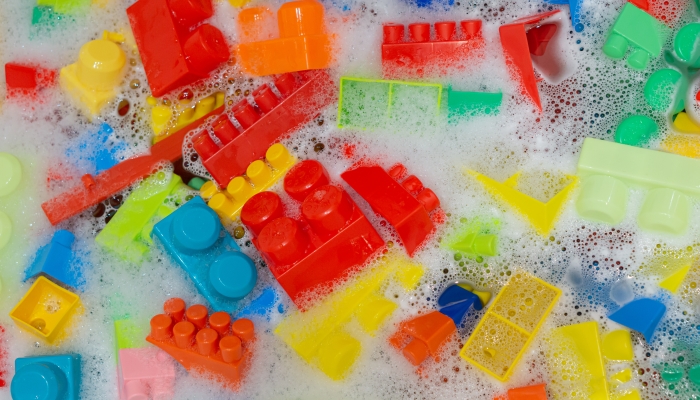
- Your child’s toys can harbor bacteria, viruses, and dust mites.
- Cleaning toys with soap and water is often all you need to keep your baby healthy.
- If you want to avoid harsh chemicals, you can naturally disinfect baby toys with vinegar, steam, or boiling water.
Your baby’s toys come into contact with many things like drool, spit-up, and the floor. It’s essential to know how to clean baby toys safely and effectively to prevent them from becoming a breeding ground for potentially harmful bacteria or vectors for viruses.
Why Should You Clean Baby Toys?
You could probably already guess that the toys in your child’s doctor’s office or kindergarten aren’t the most hygienic and act as a breeding ground for all sorts of germs and bacteria. What you might not have considered is that your household toys could also be responsible for making your little one sick.
This 2012 study found that 60% of the household toys sampled harbored at least 1 potentially pathogenic bacteria. A stomach-churning 33.3% were carrying coliforms, the bacteria present in feces, which can cause sickness and diarrhea.
Beyond those nasty germs, most stuffed animals and plush toys also house dust mites. This 2021 study found them living in 58.8% of the soft polyester toys sampled. The mites are tiny bugs belonging to the spider family and can trigger allergies and asthma attacks.
How Often Should You Clean Baby Toys?
How regularly you clean baby toys depends on what they’re made of and if they’re chewed.
| Toy Type | Mouthed | Not Mouthed |
| Hard Plastic Toys | After each use | Weekly or if visibly soiled |
| Hard Plastic Toys with Batteries | After each use | Monthly or if visibly soiled |
| Bath Toys | After each use | After each use |
| Wooden Toys | Daily | Monthly or if visibly soiled |
| Fabric Toys | Daily | Weekly or if visibly soiled |
If your child has been sick, or if other children have played with the toys, clean them before their next use.
Cleaning vs. Disinfecting
Cleaning and disinfecting aren’t the same thing. Cleaning is the process of physically removing germs and dirt, usually with soap and water. Disinfecting is killing germs by using chemicals like bleach.
Both are important, but it’s not necessary to disinfect as often as you clean. You can remove the majority of normal household germs with mild soap. It’s kinder to both the toys and the environment than harsher disinfecting products, like bleach.
Save disinfecting for toys that have been out of the house, shared on a playdate, or used when someone in the household has been sick.
What Should You Use to Clean and Disinfect Baby Toys?
Soap
Any soap, including solid bar soap, liquid hand soap, or dish detergent, will be effective for removing the majority of germs and dirt on different toys.
Vinegar
If you want to avoid harsh chemicals when cleaning toys, vinegar is naturally antimicrobial and non-toxic. This makes it a great option to disinfect baby toys naturally. However, it won’t kill as many germs as chemicals, like bleach.
Bleach
Chlorine bleach is one of the world’s cheapest and most effective disinfectants, which is why most childcare providers favor it. To clean toys, use a 0.1% solution. A tablespoon per gallon of water is usually about right.
Hydrogen Peroxide
Hydrogen Peroxide is an effective disinfectant and dust mite killer that’s slightly kinder to the environment than bleach. To clean baby toys, you should buy a 3% concentration. Use it on its own or mixed with water.
Lysol Wipes
Disinfecting wipes like Lysol wipes kill 99.9% of bacteria and viruses. The manufacturers’ websites often explain how to clean baby toys with them. Most say to leave the solution to work for 5 minutes before rinsing with water.
Washing Machine or Dishwasher
If the toy’s label says it’s suitable for machine washing or dishwasher safe, give it a go. It’s often the easiest method.
Put your child’s little toys in the dishwasher through a normal cycle on the top rack. It’s best not to put them in with the dishes from a chili or pasta sauce, just in case.
Steaming
You can kill germs on fabric toys with heat by using a clothes steamer. This method won’t remove visible dirt from the toy but will ensure it’s dust mite and germ-free.
Rubbing Alcohol
In an emergency, rubbing alcohol will disinfect baby toys. However, isopropyl alcohol is toxic if it gets into your baby’s mouth, so you must thoroughly rinse the toy with plain water before giving it back to your baby.
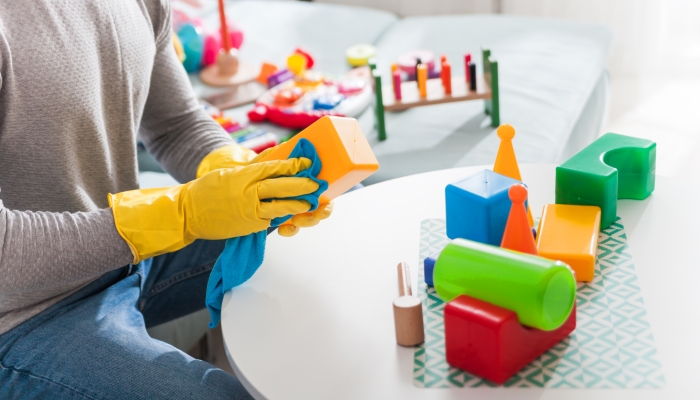
How to Clean Plastic Toys
Plastic toys are often easier to clean than other toys as they can withstand both water and chemicals. Here are your options:
Cleaning
- Remove visible dirt with a baby wipe.
- Wipe the baby toys with a cloth dipped in a mixture of warm water and dish soap.
- Put dishwasher-safe baby toys in the top rack on a normal cycle.
Disinfecting
- Spray baby toys with plain vinegar or hydrogen peroxide and leave to sit for 15 mins before rinsing with water.
- Wipe baby toys with a 0.1% bleach solution or a Lysol wipe. Leave for 5 mins and rinse with water.
- Submerge really dirty toys in a 50:50 water and hydrogen peroxide mixture or a gallon of water with a tablespoon of bleach and allow to soak for 5 minutes. Wear gloves to scrub away the softened dirt with a sponge or brush, rinse, and air dry.
Never mix bleach, hydrogen peroxide, or vinegar with each other, or any other chemical. At best, you’ll weaken their cleaning properties. At worst, you’ll create a harmful and potentially lethal gas.
How to Clean Bath Toys
Bath toys require a little extra cleaning as the moisture they’re exposed to can allow mold to grow. Cleaning them after every use is quick and easy to do as they’ll already be in the bath. Simply wipe each toy with a sponge and some mild soap at the end of bath time and leave them to air dry.
Unfortunately, this regular cleaning won’t prevent mold from forming inside the toys. If you’ve ever squeezed a rubber duck and found a jet of black slime, you’ll know the horror. If not, it’s something you’ll want to avoid.
To ensure your baby’s toys stay mold-free, clean and disinfect them once a week with a diluted bleach solution of 1 tablespoon of bleach to a gallon of plain water. Wear gloves and submerge the toys in the mixture. Squeeze them and allow them to fill with the bleach solution. Leave it to work for 5 mins and then squeeze out all of the liquid and leave to air dry.
If you want to avoid bleach, you have a few choices.
- Use a 50:50 ratio of vinegar to water. Clean the toys using the same method as the bleach but let them sit for 10 minutes before rinsing.
- Put the toys in the top rack of the dishwasher. Check they are dishwasher safe first, though.
- Boil the toys for 5 minutes. The heat will kill any mold that’s started to grow inside. Test this method on one toy before you chuck them all in the pot—just in case it melts!
How to Clean Fabric and Plush Toys in the Washer
If your baby’s stuffed toys or favorite stuffed animal are machine washable, you’re in luck. The washer is by far the easiest way to clean fabric toys.
Protect special toys from damage by putting them in a mesh bag or pillowcase and using a gentle cycle and regular detergent.
After washing toys, put them in the dryer on a cool cycle. It may take several goes to get the inner stuffing completely dry. Check embellishments, like eyes and buttons, are secure before returning the toy to your baby.
How to Clean Fabric Toys That Can’t Go in the Washer
If your fabric baby toys have electronic or hard internal parts, they won’t be able to go in the washing machine or be suitable for hand washing. In this case, you’ll only be able to clean and disinfect the surface of the toy.
Rub the surface with a clean cloth dipped in soapy water to remove visible dirt. Then allow it to air dry or use a hair dryer.
To disinfect the toy, use a clothes steamer. The heat will kill germs and mites, and the steam won’t leave behind any residues on the toy that could irritate your baby’s skin.
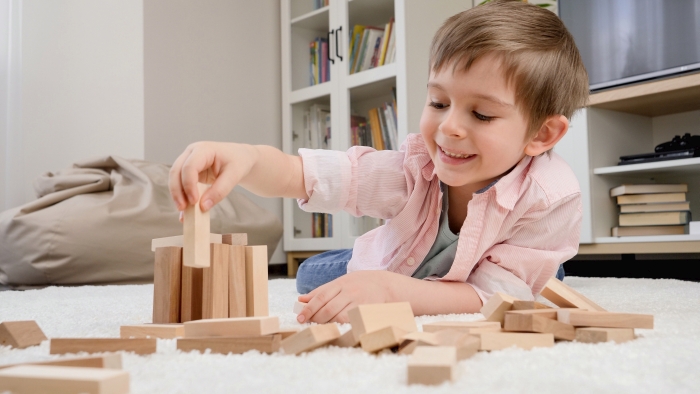
How to Clean Wooden Toys
Wooden baby toys, like building blocks, are naturally antimicrobial, so they only require cleaning once a month.
- Use a clean cloth to wipe the toy with warm soapy water.
- Use a toothbrush to scrub away tough dirt and a toothpick to get into any crevices that might harbor germs.
- Leave the toy to air dry thoroughly.
Never use bleach or hydrogen peroxide on wooden baby toys. It’ll dry them, discolor them, and might cause them to crack. If you need to disinfect wooden toys, use disinfecting wipes or vinegar.
How to Clean Squishy Toys
There are different methods of cleaning squishy toys depending on what type you have.
Foam squishies can be wiped with warm soapy water or sprayed with white shaving cream and wiped clean. They should never be submerged as they’ll absorb too much liquid and become very difficult to dry fully.
Silicone squishies can be submerged in warm water and soap and wiped gently with a cloth or your fingers. If any paint comes off, reapply it with a small paint brush and acrylic paint.
How to Clean Electronic Toys
Cleaning baby toys with batteries or that are electronic can be a little daunting, but once you know how, it’s simple to clean and disinfect them.
First, remove any batteries or unplug them. Then wipe the surface with hydrogen peroxide, a diluted bleach solution, a Lysol wipe, or a soap and water mixture. Allow the cleaning solution to sit on the surface for ten minutes before wiping it away with a clean, damp cloth.
Make sure the toy is completely dry before reinstalling the batteries or plugging it in.
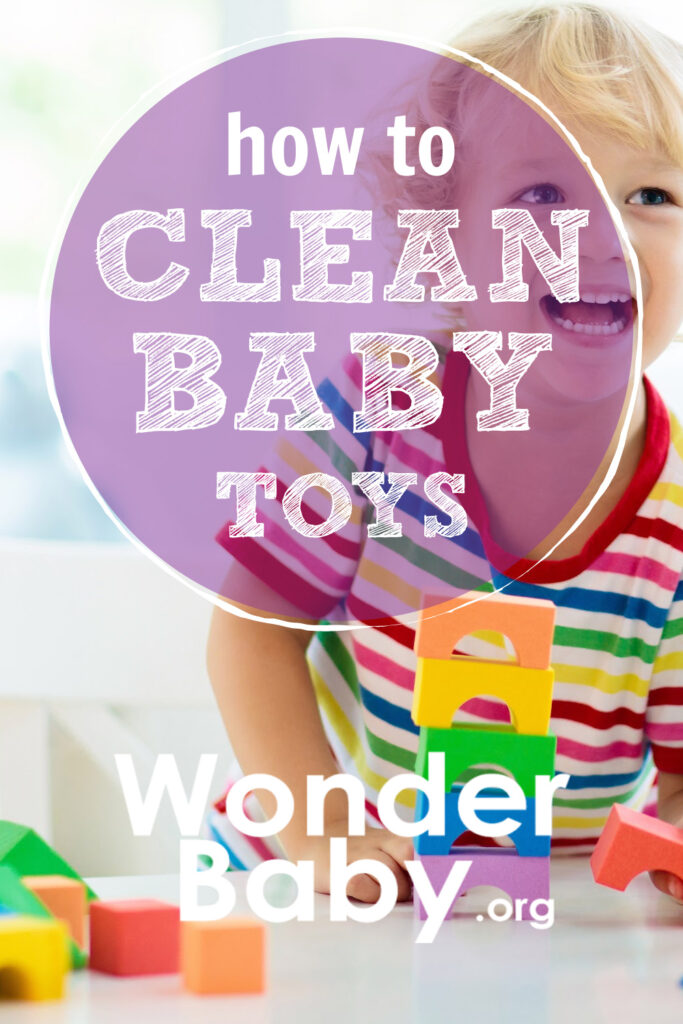
The information WonderBaby provides is not intended to be, and does not constitute, medical or other health advice or diagnosis and should not be used as such. Always consult with a qualified medical professional about your specific circumstances.
Related Posts
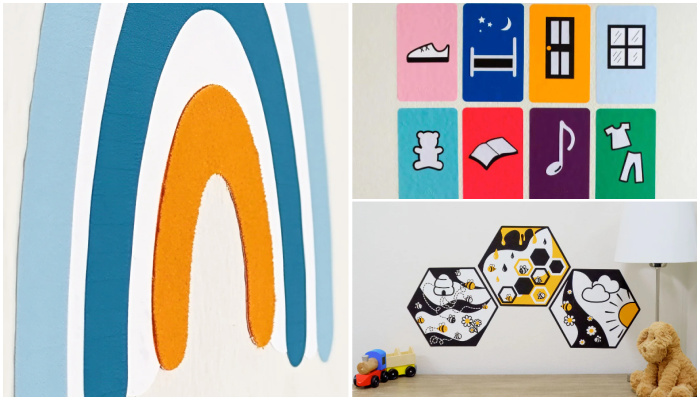
Parenting
Sensory Wall Art: 5 Tips to Create a Room Your Blind or Low-Vision Child Will Love
Even if your child can’t see their surroundings, personalizing and decorating their room with thoughtful, sensory-friendly design can make a big difference in their confidence, independence, and joy.

Braille and Literacy, Toys, Visual Impairment
24 Braille Toys for Kids Who are Blind
Everything from alphabet blocks to raised line coloring pages and activity books to puzzles to card and board games... and so much more! And it's all in braille ready for...
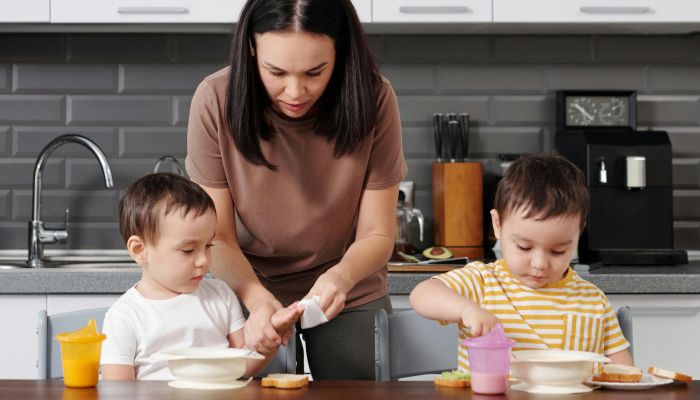
Parenting
4 Tips to Manage Twins Alone as a Single Parent
Taking care of twins alone as a single parent can feel overwhelming. Learn practical ways to help lighten the load.